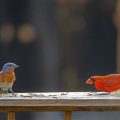Introduction to British Garden Birds
British gardens are alive with a wonderful variety of bird species, each playing a unique role in the nations natural heritage. From the cheerful Robin to the melodious Blackbird, these garden visitors are not only a delight to observe but also serve as important indicators of environmental health and local biodiversity. British garden birds have long held a special place in the hearts of people across the UK, becoming symbols in literature, folklore, and everyday life. The diversity among these birds is impressive, with different species showcasing distinct colours, sizes, behaviours, and communication styles.
| Common Name | Scientific Name | Key Features | Cultural Importance |
|---|---|---|---|
| Robin | Erithacus rubecula | Red breast, friendly presence | National bird of the UK; symbol of Christmas |
| Blackbird | Turdus merula | Glossy black (male), brown (female), yellow beak | Celebrated for its song in British poetry and music |
| Blue Tit | Cyanistes caeruleus | Blue and yellow plumage, acrobatic behaviour | Common at feeders; favourite among children |
| Sparrow | Passer domesticus | Brown-grey feathers, social flocks | Symbolises community spirit; featured in nursery rhymes |
| Woodpigeon | Columba palumbus | Large size, white neck patches, distinctive cooing call | A familiar sight in parks and gardens throughout Britain |
This rich avian tapestry makes British gardens an ideal setting for observing how birds communicate. Understanding their calls, songs, and body language not only enhances your birdwatching experience but also deepens your appreciation for their vital role within British culture.
2. The Difference Between Calls and Songs
Understanding how British garden birds communicate begins with recognising the key differences between their calls and songs. Both are vital to avian life, but they serve distinct purposes and are heard at different times in your local gardens.
Calls vs Songs: Purpose and Function
| Feature | Calls | Songs |
|---|---|---|
| Main Purpose | Communication of immediate needs, such as warning of danger or keeping in touch with flock members | Primarily used by males to attract mates and defend territory, especially during the breeding season |
| When Heard | All year round, often short and sharp; can be heard any time of day | Mainly spring and early summer, especially at dawn (the “dawn chorus”); longer and more complex |
| Who Uses Them? | Both male and female birds of all ages | Mainly adult males, though some females sing too (e.g., robin) |
| Examples in Gardens | Blackbird alarm call, blue tit contact call, wren’s scolding chatter | Song thrush’s repetitive melody, robin’s sweet warble, great tit’s “teacher teacher” song |
Listening Out in Your Garden
If you step outside on a crisp spring morning, you’re likely to hear a chorus of songs as male birds compete for attention. Calls, meanwhile, punctuate daily bird life—listen for sudden bursts if a cat prowls nearby or softer chattering as flocks forage together. By tuning into both calls and songs, you’ll gain deeper insight into what’s happening among your garden’s feathered residents.

3. Decoding Bird Calls: Examples from the British Garden
Understanding the calls of British garden birds is both fascinating and practical for anyone wanting to connect with nature in their own back garden. Each species has its own set of vocalisations, each with distinct meanings—from warning signals to calls for mates or food. Here, we’ll look at some of the most common birds found in UK gardens—robins, blackbirds, and blue tits—and decode what their typical calls mean.
Recognising Common Bird Calls
British garden birds use a range of sounds to communicate with one another and with potential threats (including us humans). By tuning into these calls, you can often predict what’s happening in your surroundings—be it a predator nearby or the start of a new breeding season.
Typical Calls and Their Meanings
| Species | Call Example | What It Means |
|---|---|---|
| Robin | Sharp “tick” or “tic” sound; melodious winter song | The ticking call usually signals alarm or territorial disputes; the sweet winter song is often a sign of territory marking, even outside breeding season. |
| Blackbird | Loud “chink-chink”; rich, fluting song at dawn and dusk | The “chink” alarm call warns of predators such as cats or magpies; their flute-like song is used to attract mates and defend territory. |
| Blue Tit | High-pitched “tsee-tsee-tsee”; short trills and scolding chatter | The rapid trilling indicates excitement or mild alarm; chattering is often a response to intruders near their nesting site. |
How to Practically Apply This Knowledge in Your Garden
If you hear a robin’s sharp ticking, pause your gardening activities—you might be close to its nest or young. A blackbird’s loud alarm may alert you to a lurking cat, prompting you to check for potential dangers. Blue tits’ excitable trills could simply mean they’ve spotted something interesting, but persistent scolding suggests you’re too close for comfort. By observing and listening regularly, you’ll soon build up a mental map of what each call means in context—a rewarding way to feel more connected with your local wildlife.
4. Songs of the Seasons: Birdsong Through the Year
British garden birds are renowned for their varied and melodious songs, but these vocalisations are not static throughout the year. Instead, bird songs change dramatically with the seasons, reflecting shifts in breeding cycles, territory defence, and social interactions. Understanding these seasonal variations can help you appreciate—and even identify—different birds in your own garden.
Spring: The Dawn Chorus
Spring is the peak season for birdsong in Britain. At dawn, male birds such as the robin, blackbird, and song thrush fill gardens with powerful, complex melodies designed to attract mates and ward off rivals. The dawn chorus is a quintessential British experience, usually at its loudest from March to early June. During this time, you may hear:
- Robins: Sweet, wistful phrases with a fluting quality
- Blackbirds: Rich, mellow notes with clear pauses between phrases
- Song Thrushes: Repetitive sequences of sharp, ringing tones
Summer: Mellowing Melodies
As summer arrives and breeding activity tapers off, bird song becomes less frequent and more subdued. Birds like the chiffchaff and willow warbler may still sing occasionally, but most garden birds focus on feeding young or moulting. You might notice shorter songs or calls used mainly for keeping in touch rather than declaring territory.
Autumn: Contact Calls Take Over
In autumn, full songs give way to simpler calls as birds form flocks and prepare for winter. Garden regulars such as tits and finches use high-pitched chirps and contact calls to maintain group cohesion while foraging. This shift marks a transition from competition to cooperation among many species.
Winter: Brief Songs and Social Sounds
During the colder months, bird song is at its quietest. Some robins continue singing softly to defend winter territories—a familiar sound on crisp mornings—but most birds rely on subtle communication like chattering or alarm calls when danger approaches.
Recognising Seasonal Birdsong in Your Garden
| Season | Main Bird Vocalisations | Purpose |
|---|---|---|
| Spring | Loud, complex songs (e.g., blackbird, robin) | Mating & territory defence |
| Summer | Softer songs & occasional calls (e.g., chiffchaff) | Feeding young & contact between mates |
| Autumn | Simpler contact calls (e.g., blue tit) | Cohesion in flocks & food finding |
| Winter | Sporadic singing (mainly robin); social chatter | Territory maintenance & social bonding |
Behavioural Tips for Garden Birdwatchers
- Listen early in the morning during spring to catch the full dawn chorus.
- Note how songs grow quieter through summer—this is normal as nesting ends.
- Look for mixed-species flocks in autumn; their calls are often high-pitched and rapid.
- A robin’s winter song is softer but persistent—an iconic sound of British gardens.
This year-round awareness of birdsong not only enhances your garden experience but also connects you with one of Britain’s most cherished natural traditions.
5. Body Language: More Than Just Sound
When we think of bird communication, songs and calls often come to mind first. However, British garden birds also rely heavily on body language to express themselves and interact with one another. In gardens across the UK, you can observe a fascinating array of postures, gestures, and movements that reveal much about what these birds are thinking and feeling.
Common Physical Behaviours in British Gardens
Many of the garden birds familiar to British homes—such as robins, blackbirds, blue tits, and wrens—use their bodies to send clear messages to both their own kind and other species. Understanding these behaviours helps us interpret their intentions and emotions more accurately.
| Behaviour | Description | Meaning | Species Example |
|---|---|---|---|
| Puffed-up feathers | Bird fluffs up its feathers, making itself appear larger | Can signal aggression or help with warmth; often used during territorial disputes or cold mornings | Robin, Blackbird |
| Wing-flicking | Quick flicks or shivers of the wings while perched | A sign of agitation, impatience, or warning to others nearby | Dunnock, Blue Tit |
| Tail-cocking | Lifting and twitching the tail upwards repeatedly | Displays alertness or readiness; sometimes an alarm gesture | Wren, Robin |
| Crouching posture | Bending low with wings slightly spread outwards | A submissive gesture or invitation for feeding (especially in fledglings) | Sparrow, Starling juvenile |
| Singing with raised head and chest puffed out | Bird stands tall, chest forward while singing loudly | A display of confidence, territory marking, or mate attraction | Blackbird, Song Thrush |
| Mobbing movement (group behaviour) | Several birds gather, flutter around and make sharp calls towards a predator or threat | A collective warning and attempt to drive away danger from the area | Tit flocks, Blackbirds vs. Cats/Magpies/Owls |
Reading Subtle Signals in Your Garden Birds
If you watch closely, you’ll notice these physical cues almost daily. For example, a robin might puff up its feathers when another robin enters its territory—a clear sign it wants to assert dominance without resorting to outright confrontation. Similarly, groups of blue tits may collectively mob a local cat or predatory magpie by fluttering excitedly and making sharp alarm calls.
Why It Matters for Birdwatchers and Gardeners in the UK
Understanding body language helps British bird enthusiasts create friendlier environments for garden visitors. By noticing signs of stress or comfort, you can adjust feeders’ locations or modify your gardening routine to minimise disturbance. Recognising when birds are relaxed versus agitated also enhances the enjoyment of observing their natural behaviours right outside your window.
6. Tips for Birdwatching in Your British Garden
Observing the fascinating ways British garden birds communicate can be both rewarding and enlightening. To make the most of your birdwatching experience while respecting local traditions, follow these practical tips:
Choose the Right Time and Place
Birds are most active during early mornings and late afternoons. Select a quiet spot in your garden with a good view of bird feeders, shrubs, or trees where birds are likely to gather. Consider placing a comfortable chair near a window or under a sheltered spot outdoors.
Essential Equipment for British Birdwatchers
| Item | Purpose |
|---|---|
| Binoculars | To observe details in plumage, behaviour, and body language from a respectful distance. |
| Field Guide (UK Edition) | For quick identification of species and understanding common calls and songs. |
| Notebook & Pen | To record observations about communication, timing, and behaviour. |
| Thermos & Blanket | To stay comfortable during chilly British mornings or drizzly afternoons. |
Interpreting Bird Communication Responsibly
- Observe Quietly: Speak softly and minimise movement to avoid startling birds. British birdwatchers value patience and discretion.
- Note Vocalisations: Listen for variations in calls and songs. Pay attention to alarm calls, which may indicate nearby predators.
- Watch Body Language: Look for wing flicks, tail movements, or head bobs. These often signal excitement, aggression, or courtship.
- Avoid Disturbance: Never approach nests or fledglings too closely. Use binoculars to maintain a safe distance and respect wildlife laws.
Respecting British Birdwatching Etiquette
The UK has a proud tradition of considerate birdwatching. Always seek permission before entering neighbouring gardens or private land. Share sightings with local bird clubs or online forums such as the RSPB’s community boards to contribute valuable information without disclosing exact nesting locations that could risk disturbance.
Common Bird Calls You Might Hear in Your Garden
| Species | Typical Call/Song | Main Message Conveyed |
|---|---|---|
| Robin | Mellifluous warble or sharp tick | Territorial claim; alarm warning |
| Blackbird | Loud, fluty song; chink alarm call | Courtship; predator alert |
| Tit (Blue/Great) | Tsee-tsee chirps; scolding chatter | Cohesion within flock; danger signal |
| Wren | Burst of trills; harsh scolds | Nesting territory; agitation when disturbed |
Your Next Steps: Join the Community!
If you’re keen to deepen your understanding of garden bird communication, consider joining a local birdwatching group or participating in annual events like the Big Garden Birdwatch. Not only will you hone your skills, but you’ll also connect with fellow enthusiasts who share your appreciation for the subtle art of avian conversation in British gardens.

